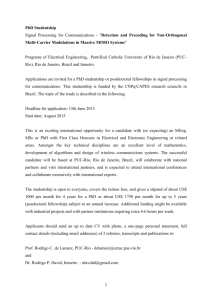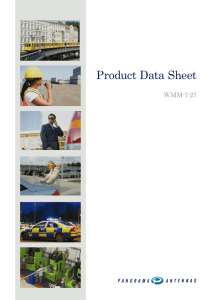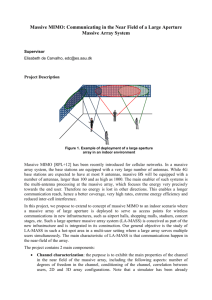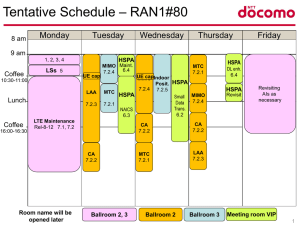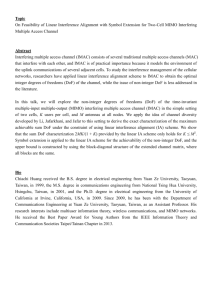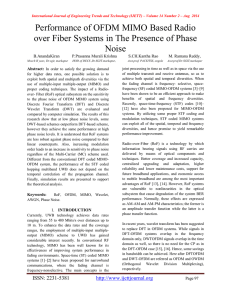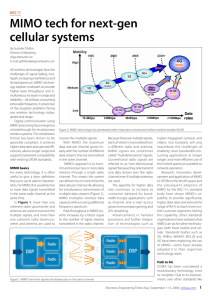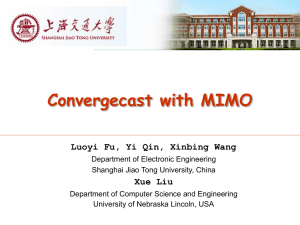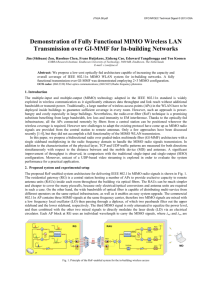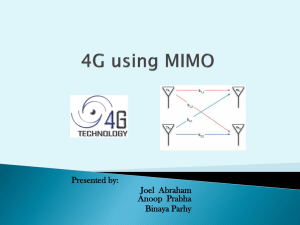Slides - SIGMOBILE
advertisement
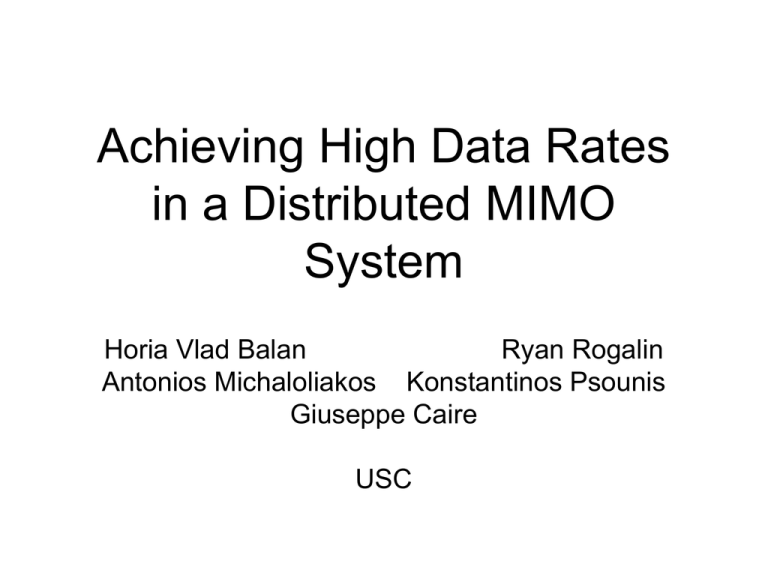
Achieving High Data Rates in a Distributed MIMO System Horia Vlad Balan Ryan Rogalin Antonios Michaloliakos Konstantinos Psounis Giuseppe Caire USC Structure of this talk •Motivation •Multiuser MIMO and precoding schemes •Distributed MIMO and synchronization •Experimental results Motivation • Cellular companies spend billions for more bandwidth • Spectrum reuse is the most promising way to increase wireless transfer rates and distributed MIMO is its ideal implementation • In WiFi networks, with a high number of users, spectrum reuse becomes equally important [Webb - The Future of Wireless Communication] Enterprise WiFi Multiuser MIMO Shannon’s Theory Increasing the Rate Prelog Factor Increase your bandwidth! Inlog Factor Increase your power exponentially!!! MIMO Communication Separate the Channels limited interference Dirty Paper Coding provides the achievable rate region Zero-Forcing -1 Tomlinson-Harashima Precoding -1 L L LU U U -1 Tomlinson-Harashima 3 3 -1 2 2 1 +2 -2 1 1 +2 +3 +4 14 (mod 5) = 4 -9 (mod 5) = Modulo4 1 Compensation -5 -4 -3 -2 -1 0 1 2 3 4 5 6 7 8 9 Tomlinson-Harashima Precoding -1 -1 mod ( mod ( mod ( L L U U U -1 U ) mod ) mod ) mod -1 Blind Interference Alignment + + 3 slots, 4 symbols => 4/3 DoFs + + + + + + + + + + + + Distributed MIMO Challenges • Maintaining phase synchronization between the different APs • Gathering channel state information and transmitting before the channel coherence time ends OFDM Modulation Subcarrier s Cyclic Prefix OFDM Symbol Carrier OFDM Demodulation I F F T FFT Distributed OFDM Symbol Alignmen t TX 1 Phase Alignmen t TX 2 RX FFT Distributed OFDM TX 1 TX 2 Random Phase Timing Offset Carrier Frequency Offset Phase Alignment Phase Alignment option 1 option 2: coherence time depends on the electronics What should be the effective channel matrix? Phase Alignment option 1 What should be the effective channel matrix? Achieving Phase Synchronization Pilot Signal Maste r Secondari es Data User Distributed MIMO Testbed Pilot Signal Master Data Secondaries TDMA point-to-point Clients (4x4 MIMO) Results Phase Accuracy ZFB F (2x2 MIMO) Channel Orthogonalization Results Tomlinson Harashima 85% rate increase (85% of the theoretical gain) (2x2 MIMO) Results Tomlinson Harashima 165% rate increase (55% of the theoretical gain) (4x4 MIMO) Results Blind Interference Alignment 22% rate increase (66% of the theoretical gain) MAC Layer Results • Comparing scheduling strategies through simulation in a 4 AP, 8 users scenario • Greedy Zero-Forcing, Tomlinson-Harashima precoding, Blind Interference Alignment • Using TDMA as a reference point Results 4x4 achievable rates (simulation) Future Work • improving the accuracy of our estimators • combining distributed MIMO with incremental redundancy schemes • characterize the channel quality variations of BIA in large deployments Questions ? Thank you!

